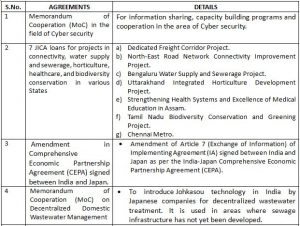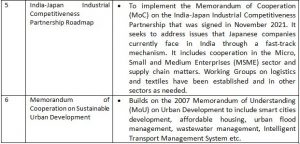THE CONTEXT: The 14thannual bilateral summit between India and Japan has held in New Delhi in March 2022. Indian Prime Minister Narendra Modi and Japanese Prime Minister Fumio Kishida participated in the summit. This article analyses the outcomes of the summit and the recent trajectory in India-Japan relations.
THE OUTCOMES OF THE SUMMIT
FOUR-POINT PLAN ON UKRAINE: India and Japan will:
- ‘not tolerate’ any unilateral and forceful change in the status quo of Ukraine or any country in the world,
- continue to push for a peaceful settlement of the conflict,
- jointly address the situation whenever needed, and
- work together in giving humanitarian aid and assistance to Ukraine.
ON INDO-PACIFIC:
- Both countries expressed their commitment to a free and peaceful Indo-Pacific. Moreover, the leaders showed their commitment to promoting peace, security, and prosperity in the Indo-Pacific region.
ON QUAD:
- The two PMs affirmed the importance of bilateral and plurilateral partnerships among like-minded countries, including the QUAD grouping between India-Australia-Japan and the United States.
ON CHINA:
- India raises China-LAC standoff with Japan.
- Japan raised the matter of the East China Sea and the South China Sea with regard to China’s growing belligerence there.
ON TERRORISM:
- Both the countries expressed deep concern about the growing threat of terrorism and underlined the need to strengthen international cooperation to combat terrorism comprehensively and sustainably.
ON INVESTMENT:
- Japan’s PMannounced an investment to the tune of $42 billion (JPY 5 trillion) in India over the next five years.
LIST OF AGREEMENTS/MOUs SIGNED


INDIA -JAPAN RELATIONS: A HISTORICAL PERSPECTIVE
- Begun in the 6th century when Buddhism was introduced to Japan.
- After World War II, in 1949, India started relations with Japan warmly.
- Japan and India signed a peace treaty and established diplomatic relations on 28th April 1952. This treaty was one of Japan’s first peace treaties after World War II.
- In the post-World War II period, India’s iron ore helped a great deal in Japan’s recovery from the devastation.
- Japan started providing yen loans to India in 1958, as the first yen loan aid extended by the Japanese government.
- The visit of then Japanese Crown Prince Akihito and Crown Princess Michiko in 1960 elevated the relations to a new level. A test of the reliability of Japan as a friend was witnessed in 1991 when Japan was among the few countries that bailed India out of the balance of payment crisis.
PROGRESS IN THE RECENT PAST
RECENT RELATIONS:
- Prime Minister Yoshiro Mori’s visit to India in 2000 provided momentum to strengthen the Japan-India relationship.
- In 2005, Japan-India annual summit started.
- In December 2006, the relationship was elevated to the “Global and Strategic Partnership”.
- In September 2014, upgrade the bilateral relationship to “Special Strategic and Global Partnership.”
- In 2015 both countries resolved to transform the Japan-India Special Strategic and Global Partnership into a deep, broad-based, action-oriented partnership, reflecting a broad convergence of their long-term political, economic, and strategic goals.
- The announcement “Japan and India Vision 2025 Special Strategic and Global Partnership Working Together for Peace and Prosperity of the Indo-Pacific Region and the World” started a new era in Japan-India relations.
- in October 2018, both countries reiterated their unwavering commitment to working together towards a “Free and Open Indo-Pacific”.
- In September 2021 both countries again concurred to further develop Japan-India relations and work closely toward the realization of a “Free and Open Indo-Pacific”.
COOPERATION IN SECURITY FIELDS:
- In 2008, “the Joint Declaration on Security Cooperation between Japan and India” was issued.
- ‘2+2” meeting, annual Defense Ministerial Dialogue, and Coast Guard-to-Coast Guard dialogue.
- JIMEX, EX DHARMA GUARDIAN, SHINYUU Maitri, and Dharma Guardian are some military exercises between both countries. Apart from these, both countries are participatory in Malabar naval exercises.
- In September 2020, the Agreement concerning Reciprocal Provision of Supplies and Services between the Self-Defense Forces of Japan and the Indian Armed Forces (so-called “Acquisition and Cross-Servicing Agreement” or ACSA) was signed. ACSA came into force on July 11th, 2021
ECONOMIC RELATIONS:
- In recent years, the economic relationship between Japan and India has increased.
- India was the 18th largest trading partner for Japan, and Japan was India’s 12th largest trading partner in 2020.
- Japan was the 4th largest investor for India in FY2020.
- Japanese private-sector’s interest in India is rising, and, currently, about 1,455 Japanese companies have branches in India. Maruti Suzuki, Toyota, Mitsubishi, Honda, and Hitachi are some of the major Japanese companies operating in India.
- Currency Swap Arrangement of USD 75 billion between both countries.
ECONOMIC ASSISTANCE:
- India has been the largest recipient of Japanese (Official Development Assistance) ODA loans for the past decades.
- Delhi Metro is one of the most successful examples of Japanese cooperation.
- Japan continues to cooperate in supporting strategic connectivity linking South Asia to Southeast Asia through the synergy between the ”Act East” policy and ”Partnership for Quality Infrastructure.”
- Besides, Japan and India had committed to building a High-Speed Railway in India by introducing Japan’s Shinkansen System, the flagship project of Japan-India relations.
CULTURAL RELATIONS:
- The year 2022 marked the 70th anniversary of the establishment of diplomatic relations between Japan and India. Various cultural events took place in Japan and India to promote mutual understanding between the two countries, under the theme of “Resurgent Japan, Vibrant India: New Perspectives, New Exchanges.”
WHAT IS THE IMPORTANCE OF JAPAN TO INDIA?
FINANCIAL:
- Japan has invested in the $90 billion Delhi-Mumbai Industrial Corridor (1,483km high-speed rail and road line), which will set up new cities, industrial parks, ports, and airports.
- It is also backing the Ahmedabad-Mumbai bullet train service and has already released the first tranche of 5,500 crore rupees.
- Japan is the third-largest source of FDI ($28.160 billion between2000 June 2018) investment into India after Mauritius and Singapore.
- In Dedicated Freight Corridor, a project of close to Rs 50,000 crore of Japanese assistance has been about Rs 38,000 crore.
- A 75 Billion dollar currency swap agreement between countries is a significant step in enhancing economic ties.
DEFENCE:
- Japan is the most important partner in the Indo-Pacific region. Both countries are the part of QUAD group.
- After the joint army, navy, and air force exercises, the two nations are looking to allow their respective naval forces to use each other’s facilities.
- Both countries have conflicts with China and to counter its behaviour in the Indo-Pacific region, they need to continue helping each other.
TECHNOLOGY:
- The introduction of Johkasou technology in India by Japanese companies for decentralized wastewater treatment will help in sewage water management.
- The Indian PM and the then PM of Japan Mr. Abe have also announced the launch of a new digital partnership that will cover Artificial Intelligence (AI) and the Internet of Things (IoT).
- In 2018, when the Indian PM visited Japan, he made a trip to FANUC Corporation, one of the world’s largest makers of industrial robots.
- FANUC facility is important in the context of India’s move towards Industry 4.0.
INFRASTRUCTURE COOPERATION:
- In 2016, India and Japan announced joint projects in Africa as part of the Asia-Africa Growth Corridor; the main aim of this project is to counter the BRI influence in South Asia and Africa.
- Apart from it, there are many joint ventures between the two countries.
THE AREAS OF CONCERNS
TRADE BETWEEN TWO COUNTRIES:
- Today, India-Japan trade languishes at around $18 billion, while Japan-China trade is around $300 billion.
- India’s major exports to Japan include petroleum products, organic chemicals, fish and aquatic invertebrates, natural or cultured pearls, precious or semi-precious stones, and machinery and mechanical appliances.
- India’s top import items from Japan are machinery and mechanical appliances, followed by electronics, iron and steel, plastics, copper, and its articles.
RELATIONSHIP CENTRED ON COUNTERING CHINA:
- Both countries have border issues with China. So the relations generally target China.
- It is interesting fact, that China is the biggest trading partner of Japan and India.
SECURITY TIES:
- In security ties, the Indo-Japanese relationship has remained below potential, and Japan does not accord due to importance to India in its security calculus.
- Japan has offered neither military hardware nor technology to India. There seems to be a difference in perceptions about China; Japan, while highlighting its own security concerns in the East and South China Seas, is seen to play down the multiple threats that India faces from China.
- Although both countries are members of QUAD and have 2+2 talks, there is a large scope to improve the security relations that are not developed as per the demand of time.
THE UKRAINE CRISIS:
- On the issue of the ongoing Russia-Ukraine war, while India took a neutral stance, Japan criticized the attack openly and followed NATO. This shows that despite being the partner of QUAD, both countries follow their independent foreign policy.
- During his visit, Japan’s Prime Minister pushed Narendra Modi to take a clear stance on Russia’s war on Ukraine. This shows a divergence between both countries but later, QUAD itself accepted India’s stand on the Ukraine-Russia war.
THE WAY FORWARD: HOW TO SHAPE THE FUTURE OF INDIA-JAPAN RELATION?
SHOULD GO BEYOND COUNTERING CHINA:
- The Indo-Japan relations are oriented toward countering Chinese Influence in the Indian Ocean and the South China Sea but now both the countries should go beyond.
SHOULD FOCUS ON THE BILATERAL TRADE:
- Both governments should focus on boosting trade which is standing at just $18 billion. It shows that bilateral trade needs to be increased.
- The scope in many areas for improving trade and the fourth industrial revolution can be a landmark in this regard.
LEVERAGE OPPORTUNITIES FOR COOPERATION:
- Japan gives India an opportunity to boost its relations with Indo-Pacific countries.
- There are many other areas providing opportunities such as the African continent through the Asia Africa Growth Corridor(AAGC) whose potential needs to be utilized and scaled up.
NEED STRONG SECURITY TIES:
- India and Japan are the members of Quad and India invited Japan in Malabar Naval Exercise but these are multi-country level ventures. Both counties should focus on their own security setup in their respective regions.
- As a significant naval power with a dominant peninsular location astride shipping lanes, India plays a major role in ensuring maritime security in the Indian Ocean and its environs.
- Close cooperation with a democratic India, located mid-way along trade routes connecting East Asia with the Middle East and Africa, would be advantageous to Japan.
- At the same time, a technologically deficient India has much to gain from a relationship with a country like Japan.
THE CONCLUSION: No doubt, India and Japan are among the most reliable partners in bilateral relations and Japan-India relations have evolved into an inclusive and multi-layered relationship based on cultural bonds, firm friendship, and common universal values. But, there is still scope for improving the bilateral relations which should be the agenda of their future relations.
Questions
- ‘With strong India-Japan cooperation, 21st century will be Asia’s century. Analyze the scope for India-Japan relations in changing geopolitical scenarios.
- Highlight the importance of strong India- Japan relations for a free and secure Indo-Pacific.
- ‘Without enhancing trade relations, India and Japan would not be able to counter China’s influence in Indo-pacific’. Critically Analyze.

